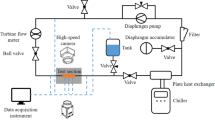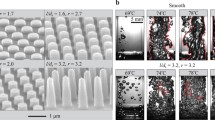Abstract
Microstructured surfaces have been extensively employed to enhance nucleate boiling. However, enhancement mechanisms have not been fully understood. In this work, a three-dimensional numerical model is developed to investigate growth and departure dynamics of a single bubble for nucleate boiling on a micropillar-structured surface. In the model, the volume of fluid method is used to capture vapor–liquid interfaces, and evaporations in both vapor–liquid interface and microlayer are taken into account. Moreover, a pressure outlet boundary condition is proposed to reasonably describe the inflow and outflow on side surfaces of the computational domain. The focus of this work is to answer how the location of nucleation site affects bubble dynamics and the resultant heat transfer characteristics. Two typical locations are considered: the center in the micropillar gap and the corner between the micropillar and substrate, referred to as the center nucleation and corner nucleation. The results show that the bubble with the center nucleation exhibits symmetric growth and departure, whereas the symmetry is broken up for the bubble with the corner nucleation. Asymmetric growth and departure induce asymmetric temperature profiles inside/around the bubble, leading to a faster departure and a smaller departure diameter for the bubble with the corner nucleation. Moreover, contributions of microlayer evaporation and vapor–liquid interface evaporation for the two nucleation locations are also discussed.

















Similar content being viewed by others
Abbreviations
- A b–p :
-
Contact area between bubble and micropillars/mm2
- A b–s :
-
Contact area between bubble and substrate/mm2
- A surface :
-
Contact area between microlayer cell and solid wall/m2
- C p :
-
Specific heat at constant pressure/J kg−1 K−1
- E :
-
Total energy per unit mass/J kg−1
- F b :
-
Buoyancy/N
- \(\overrightarrow {{F_{\text{m}} }}\) :
-
Source term of vapor/liquid mass transfer rate due to evaporation for Navier–Stokes equation/kg m−2 s−2
- F s :
-
Surface tension/N
- \(\overrightarrow {{F_{\upsigma} }}\) :
-
Source term of surface tension for Navier–Stokes equation/kg m−2 s−2
- \(\overrightarrow {g}\) :
-
Gravitational acceleration/m s−2
- h lv :
-
Latent heat of vaporization/J kg−1
- h surface :
-
Boiling heat transfer coefficient of entire micropillar-structured surface/W m−2 K−1
- k :
-
Thermal conductivity/W m−1 K−1
- \(\dot{m}\) :
-
Phase change rate due to evaporation in the cell/kg m−3 s−1
- \(\overrightarrow {n}\) :
-
Unit vector normal to interface
- p :
-
Pressure/Pa
- \(\dot{Q}_{\text{h}}\) :
-
Energy term caused by latent heat of vaporization for energy equation/J m−3 s−1
- \(\dot{Q}_{\text{m}}\) :
-
Internal energy term of vapor/liquid mass transfer rate due to evaporation for energy equation/J m−3 s−1
- q :
-
Heat flux/kW m−2
- R :
-
Universal gas constant/8.314 J mol−1 K−1
- R s :
-
Bubble bottom radius/m
- r :
-
Horizontal distance between microlayer cell and nucleation site/m
- T :
-
Temperature/K
- t :
-
Time/s
- \(\overrightarrow {t}\) :
-
Unit vector tangent to interface
- \(\overrightarrow {u}\) :
-
Velocity vector/m s−1
- V bubble :
-
Bubble volume/mm3
- α :
-
Volume fraction
- δ 0 :
-
Initial microlayer thickness/m
- δ(t):
-
Microlayer thickness/m
- θ :
-
Static contact angle/°
- κ :
-
Curvature of vapor–liquid interface/m−1
- μ :
-
Dynamic viscosity/kg m−1 s−1
- ρ :
-
Density/kg m−3
- σ :
-
Surface tension coefficient/N m−1
- CEN:
-
Center nucleation
- CON:
-
Corner nucleation
- L:
-
Bubble L region
- l:
-
Liquid phase
- lv:
-
Vapor–liquid interface
- ml:
-
Microlayer
- pillar_side:
-
Side surface of micropillar
- pillar_top:
-
Top surface of micropillar
- R:
-
Bubble R region
- sat:
-
Saturation
- substrate:
-
Substrate
- v:
-
Vapor phase
- W:
-
Solid wall
References
Mudawar I. Assessment of high-heat-flux thermal management schemes. IEEE Trans Compon Packag Technol. 2001;24:122–41.
Mudawar I. Recent advances in high-flux, two-phase thermal management. J Therm Sci Eng Appl. 2013;5:021012.
Akbari A, Alavi FSA, Maghsoodi S, Kootenaei AS. Pool boiling heat transfer characteristics of graphene-based aqueous nanofluids. J Therm Anal Calorim. 2019;135:697–711.
Salehi H, Hormozi F. Prediction of Al2O3-water nanofluids pool boiling heat transfer coefficient at low heat fluxes by using response surface methodology. J Therm Anal Calorim. 2019;137:1069–82.
Liang G, Mudawar I. Review of pool boiling enhancement by surface modification. Int J Heat Mass Transf. 2019;128:892–933.
Dikici B, Eno E, Compere M. Pool boiling enhancement with environmentally friendly surfactant additives. J Therm Anal Calorim. 2014;116:1387–94.
Wei JJ, Honda H. Effects of fin geometry on boiling heat transfer from silicon chips with micro-pin-fins immersed in FC-72. Int J Heat Mass Transf. 2003;46:4059–70.
Dong L, Quan X, Cheng P. An experimental investigation of enhanced pool boiling heat transfer from surfaces with micro/nano-structures. Int J Heat Mass Transf. 2014;71:189–96.
Yu DI, Kwak HJ, Noh H, Park HS, Fezzaa K, Kim MH. Synchrotron x-ray imaging visualization study of capillary-induced flow and critical heat flux on surfaces with engineered micropillars. Sci Adv. 2018;4:e1701571.
Kharangate CR, Mudawar I. Review of computational studies on boiling and condensation. Int J Heat Mass Transf. 2017;108:1164–96.
Zhao Z, Zhang J, Jia D, Zhao K, Zhang X, Jiang P. Thermal performance analysis of pool boiling on an enhanced surface modified by the combination of microstructures and wetting properties. Appl Therm Eng. 2017;117:417–26.
Zhou Z, Shi J, Chen HH, Schafer SR, Chen CL. Two-phase flow over flooded micro-pillar structures with engineered wettability pattern. Int J Heat Mass Transf. 2014;71:593–605.
Chen B, Zhou Z, Shi J, Schafer SR, Chen CL. Flooded two-phase flow dynamics and heat transfer with engineered wettability on microstructured surfaces. J Heat Transfer. 2015;137:091021.
Lee W, Son G, Yoon HY. Numerical study of bubble growth and boiling heat transfer on a microfinned surface. Int Commun Heat Mass Transfer. 2012;39:52–7.
Lee W, Son G. Three-dimensional simulation of bubble growth on horizontal microstructured surfaces. In: Proceedings of Cht-12: Ichmt international symposium on advances in computational heat transfer. Begell House, Inc. 2012. pp. 1091–110.
Lee WH. Pressure iteration scheme for two-phase flow modeling. In: Veziroglu TN, editor. Multiphase transport: fundamentals, reactor safety, applications, vol. 1. Washington DC: Hemisphere Publishing; 1980. p. 407–31.
Judd RL, Hwang KS. A comprehensive model for nucleate pool boiling heat transfer including microlayer evaporation. J Heat Transfer. 1976;98:623–9.
Benjamin RJ, Balakrishnan AR. Nucleate pool boiling heat transfer of pure liquids at low to moderate heat fluxes. Int J Heat Mass Transf. 1996;39:2495–504.
Yabuki T, Nakabeppu O. Heat transfer mechanisms in isolated bubble boiling of water observed with MEMS sensor. Int J Heat Mass Transf. 2014;76:286–97.
Gibou F, Chen L, Nguyen D, Banerjee S. A level set based sharp interface method for the multiphase incompressible Navier–Stokes equations with phase change. J Comput Phys. 2007;222:536–55.
Kunkelmann C, Stephan P. Numerical simulation of the transient heat transfer during nucleate boiling of refrigerant HFE-7100. Int J Refrig. 2010;33:1221–8.
Chen Z, Utaka Y. On heat transfer and evaporation characteristics in the growth process of a bubble with microlayer structure during nucleate boiling. Int J Heat Mass Transf. 2015;81:750–9.
Sato Y, Niceno B. A depletable micro-layer model for nucleate pool boiling. J Comput Phys. 2015;300:20–52.
Sato Y, Niceno B. Nucleate pool boiling simulations using the interface tracking method: boiling regime from discrete bubble to vapor mushroom region. Int J Heat Mass Transf. 2017;105:505–24.
Lay JH, Dhir VK. Shape of a vapor stem during nucleate boiling of saturated liquids. Trans ASME J Heat Transfer. 1995;117:394–401.
Pastuszko R. Pool boiling heat transfer on micro-fins with wire mesh: experiments and heat flux prediction. Int J Therm Sci. 2018;125:197–209.
Chen HX, Sun Y, Gong YF, Huang LB. Visual measurement and data analysis of pool boiling on silicon surfaces. J Chem Ind Eng (China). 2019;90:1309–17 (in Chinese).
Hirt CW, Nichols BD. Volume of fluid (VOF) method for the dynamics of free boundaries. J Comput Phys. 1981;39:201–25.
Brackbill JU, Kothe DB, Zemach C. A continuum method for modeling surface tension. J Comput Phys. 1992;100:335–54.
Sun DL, Xu JL, Wang L. Development of a vapor-liquid phase change model for volume-of-fluid method in FLUENT. Int Commun Heat Mass Transfer. 2012;39:1101–6.
Utaka Y, Kashiwabara Y, Ozaki M. Microlayer structure in nucleate boiling of water and ethanol at atmospheric pressure. Int J Heat Mass Transf. 2013;57:222–30.
Hsu YY. On the size range of active nucleation cavities on a heating surface. J Heat Transfer. 1962;84:207–13.
Carey VP. Liquid-vapor phase-change phenomena. New York: Hemisphere Publishing; 1992.
Issa RI. Solution of the implicitly discretised fluid flow equations by operator-splitting. J Comput Phys. 1986;62:40–65.
Karri SBR. Dynamics of bubble departure in micro-gravity. Chem Eng Commun. 1988;70:127–35.
Acknowledgements
This study was partially supported by the National Natural Science Foundation of China (No. 51576063) and Youth Talents Project of Joint Funds of Ministry of Education for Equipment Pre-research in 2019 (6141A02033526).
Author information
Authors and Affiliations
Corresponding author
Additional information
Publisher's Note
Springer Nature remains neutral with regard to jurisdictional claims in published maps and institutional affiliations.
Rights and permissions
About this article
Cite this article
Chen, HX., Sun, Y., Xiao, HY. et al. Bubble dynamics and heat transfer characteristics on a micropillar-structured surface with different nucleation site positions. J Therm Anal Calorim 141, 447–464 (2020). https://doi.org/10.1007/s10973-020-09301-x
Received:
Accepted:
Published:
Issue Date:
DOI: https://doi.org/10.1007/s10973-020-09301-x




